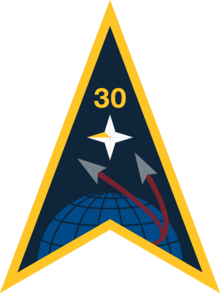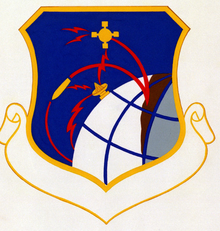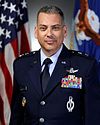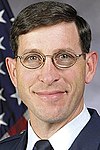Space Launch Delta 30
| Space Launch Delta 30 | |
|---|---|
 Emblem of Space Launch Delta 30 | |
| Founded | 19 November 1991; 30 years, 2 months 15 May 1964 (as Air Force Western Test Range) |
| Country | |
| Branch | |
| Type | Space wing |
| Role | Space launch |
| Part of | Space Systems Command |
| Headquarters | Vandenberg Space Force Base, California, U.S. |
| Mascot(s) | Hawks |
| Decorations | Air Force Outstanding Unit Award Air Force Organization Excellence Award[1] |
| Website | www |
| Commanders | |
| Commander | Col Robert A. Long[2] |
| Vice Commander for Operations | Col Kris Barcomb[3] |
| Vice Commander for Support | Col Michael Hunsberger[4] |
| Command Chief | CMSgt Jason R. DeLucy[5] |
| Insignia | |
| Guidon |  |
Space Launch Delta 30 (SLD 30) is a United States Space Force space launch delta assigned to Space Systems Command and headquartered at Vandenberg Space Force Base, California. The Space Launch Delta 30 is responsible for all space launch operations from the west coast, which includes all polar launches. It manages the Western Range and launch activities for the Space Force, Department of Defense, NASA, and other private space corporations. The Space Launch Delta 30 also supports test and evaluation launches of the U.S. Air Force's intercontinental ballistic missile force.
Operations[]
The Space Launch Delta 30 is one of two space launch wings for the U.S. Space Force, being responsible for executing military, intelligence, civil, and commercial space launches using the Western Range. Primary launch vehicles include the Atlas V, Delta IV, Pegasus, Minotaur, and Falcon rockets. It also supports Air Force Global Strike Command ballistic missile tests and evaluation and Missile Defense Agency test and operations.[6]
The Space Launch Delta 30 serves as the host wing for Vandenberg Space Force Base, providing base support for the Space Force's Space Operations Command and its Space Delta 5, and the Space Delta 6's 21st Space Operations Squadron. The Space Launch Delta 30 also provides support to non-Space Force units, such as the Air Force's 532d Training Squadron and 576th Flight Test Squadron, Space Command's Combined Force Space Component Command and Combined Space Operations Center, and elements of the Missile Defense Agency, National Reconnaissance Office, and NASA.[7]
Structure[]
![]() 30th Operations Group (30 OG)[8]
30th Operations Group (30 OG)[8]
 2nd Range Operations Squadron (2 ROPS)
2nd Range Operations Squadron (2 ROPS) 2nd Space Launch Squadron (2 SLS)
2nd Space Launch Squadron (2 SLS)(30 OSS)
 (30 SCS)
(30 SCS)
![]() 30th Mission Support Group (30 MSG)
30th Mission Support Group (30 MSG)
 (30 CES)
(30 CES) (30 CONS)
(30 CONS)- (30 FSS)
 (30 LRS)
(30 LRS) (30 SFS)
(30 SFS)
![]() (30 MDG)
(30 MDG)
- (30 HCOS)
- (30 OMRS)
(30 CPTS)
Shield[]

The 30th Space Wing shield was approved for use on 13 March 1995. The blue and yellow in the shield are the Air Force's colors, which the wing was a part of when the shield was created. The blue alludes to the sky, while the Yellow refers to the sun and the excellence required of its personnel. The two launch vehicles emanating from behind the globe represent the 30th Space Wing's intercontinental ballistic missile test and space launch missions. The remaining red, white, and blue elements represent the national colors of the United States.[9]
History[]
Air Force Western Test Range (1964–1970)[]

The Air Force Western Test Range (AFWTR) was established on 15 May 1964. Initially organized as part of Air Force Systems Command's National Range Division, the Air Force Western Test Range managed all space and missile launches from the West Coast of the United States, which primarily were launched from Vandenberg Air Force Base. The AFWTR established a network of instrumentation sites along the California coast and in the Pacific islands to monitor ballistic missile and space launches in its region, although actual launches were conducted by the Space Systems Division's 6595th Aerospace Test Wing.[9][10]
On 1 April 1970 the Air Force Western Test Range was inactivated, as the responsibility for managing the range was passed to the Space and Missile Systems Organization's Space and Missile Test Center.[10]
Western Space and Missile Center (1979–1991)[]
In 1979 the Space and Missile Test Center was reorganized, becoming the Space and Missile Test Organization and the Air Force Western Test Range was reestablished on 1 October 1970 as the Western Space and Missile Center (WSMC), replacing the 6595th Aerospace Test Wing. Organized under the new center were the 6595th Aerospace Test Group, 6595th Test and Evaluation Group, and the 6595th Shuttle Test Group.[10][1]
Initially designated as the 6595th Satellite Test Group, the 6595th Aerospace Test Group managed space launches from Vandenberg Air Force Base. The 6595th Test and Evaluation Group was initially designated as the 6595th Missile Test Group, performing missile tests for the LGM-118 Peacekeeper and LGM-30 Minuteman intercontinental ballistic missiles. Initially planned to serve as an alternate launch and landing location for the Space Shuttle, the 6595th Shuttle Group was intended to prepare facilities for its operations, before shuttle operations from Vandenberg AFB were canceled in 1987.[9][1]
On 1 October 1979 the Space and Missile Test Organization was inactivated and the Western Space and Missile Center was directly subordinated to the Space Systems Division. A year later Air Force Systems Command began to transition the space launch mission to Air Force Space Command. On 1 October 1990 the Western Space and Missile Systems Center transferred to Air Force Space Command's 9th Space Division. Vandenberg Air Force Base had been a Strategic Air Command installation until 15 January 1991, when it became an Air Force Space Command base, with the Western Space and Missile Systems Center as the host organization. After the 9th Space Division was inactivated on 1 October 1991, the Western Space and Missile Systems Center directly reported to Air Force Space Command.[10][1][9]
30th Space Wing (1991–2021)[]
On 19 November 1991, as part of a larger Air Force heritage initiative, the Western Space and Missile Center was redesignated as the 30th Space Wing (30 SW), with the 30th Operations Group assuming the lineage of the World War II-era 30th Bombardment Group (Heavy). The Western Test Range was also renamed as the Western Range, to emphasize its operational nature. On 1 July 1993 the 30th Space Wing was assigned to the newly-reactivated Fourteenth Air Force.[9]
On 1 December 2003 the 30th Launch Group was activated to manage launch operations. On 20 July 2018 the 30th Launch Group was reemerged with the 30th Operations Group in an effort to streamline Air Force Space Command organizations.[1][11]
On 20 December 2019 the 30th Space Wing, along with the rest of Air Force Space Command became part of the United States Space Force. The Fourteenth Air Force was redesignated as Space Operations Command, which the 30th Space Wing remained assigned to.[12]
Space Launch Delta 30 (2021–present)[]
Upon the activation of Space Systems Command, the 30th Space Wing was transferred over from Space Operations Command and was renamed as Space Launch Delta 30.[13][14]
List of commanders[]
| No. | Commander | Term | |||
|---|---|---|---|---|---|
| Portrait | Name | Took office | Left office | Duration | |
| 30th Space Wing | |||||
| 1 | Brigadier General | 10 September 1991 | 13 August 1993 | 1 year, 337 days | |
| 2 | Brigadier General Lance W. Lord | 13 August 1993 | 7 August 1995 | 3 years, 331 days | |
| 3 | Colonel Franklin J. Blaisdell | 7 August 1995 | 5 June 1996 | 303 days | |
| 4 | Colonel C. Robert Kehler | 5 June 1996 | 15 June 1998 | 2 years, 10 days | |
| 5 | Colonel Roosevelt Mercer Jr. | 15 June 1998 | 11 June 1999 | 361 days | |
| 6 | Colonel | 11 June 1999 | 30 May 2001 | 1 year, 353 days | |
| 7 | Colonel | 30 May 2001 | 16 June 2003 | 2 years, 17 days | |
| 8 | Colonel | 16 June 2003 | 30 June 2005 | 2 years, 14 days | |
| 9 | Colonel Jack Weinstein | 30 June 2005 | 5 March 2007 | 1 year, 248 days | |
| 10 | Colonel | 5 March 2007 | 27 June 2008 | 1 year, 114 days | |
| 11 | Colonel David J. Buck | 27 June 2008 | 26 April 2010 | 1 year, 303 days | |
| 12 | Colonel | 26 April 2010 | 23 January 2012 | 1 year, 272 days | |
| 13 | Colonel Nina M. Armagno | 23 January 2012 | 28 May 2013 | 1 year, 125 days | |
| 14 | Colonel | 28 May 2013 | 9 July 2015 | 4 years, 42 days | |
| 15 | Colonel | 9 July 2015 | 9 June 2017 | 1 year, 335 days | |
| 16 | Colonel | 9 June 2017 | 12 July 2019 | 2 years, 33 days | |
| 17 | Colonel Anthony J. Mastalir | 12 July 2019 | 14 May 2021 | 2 years, 191 days | |
| Space Launch Delta 30 | |||||
| 17 | Colonel Anthony J. Mastalir[15] | 14 May 2021 | 11 June 2021 | 28 days | |
| 18 | Colonel [2] | 11 June 2021 | Incumbent | 222 days | |
References[]
| Wikimedia Commons has media related to Space Launch Delta 30. |
![]() This article incorporates public domain material from the Air Force Historical Research Agency website http://www.afhra.af.mil/.
This article incorporates public domain material from the Air Force Historical Research Agency website http://www.afhra.af.mil/.
- ^ a b c d e "30 Space Wing (AFSPC)". Air Force Historical Research Agency.
- ^ a b "Colonel Robert A. Long". www.vandenberg.af.mil.
- ^ "Colonel Kris E. Barcomb". www.vandenberg.spaceforce.mil.
- ^ "Colonel Michael G. Hunsberger". www.vandenberg.spaceforce.mil. Archived from the original on 20 August 2021.
- ^ "Chief Master Sergeant Jason R. DeLucy". www.vandenberg.spaceforce.mil.
- ^ "Vandenberg Space Force Base > Home".
- ^ "Vandenberg Space Force Base > Home".
- ^ "Vandenberg Space Force Base > Home". www.vandenberg.spaceforce.mil.
- ^ a b c d e "Vandenberg Space Force Base > Home".
- ^ a b c d https://www.losangeles.af.mil/Portals/16/documents/AFD-060912-021.pdf?ver=2016-05-02-112844-290
- ^ "Vandenberg Space Force Base > Home".
- ^ "14th Air Force redesignated as Space Operations Command". U.S. Air Force.
- ^ "USSF Unveils Space Systems Command's Structure". 8 April 2021.
- ^ "Vandenberg Air Force Base being renamed". KSBY. 11 May 2021. Retrieved 19 May 2021.
- ^ "Col. Anthony J. Mastalir". www.spoc.spaceforce.mil.
- Wings of the United States Space Force
- Military units and formations in California
- Military units and formations established in 1964
- Deltas of the United States Space Force

















![Robert A. Long[2]](http://upload.wikimedia.org/wikipedia/commons/thumb/0/04/Col_Robert_A._Long.jpg/100px-Col_Robert_A._Long.jpg)

